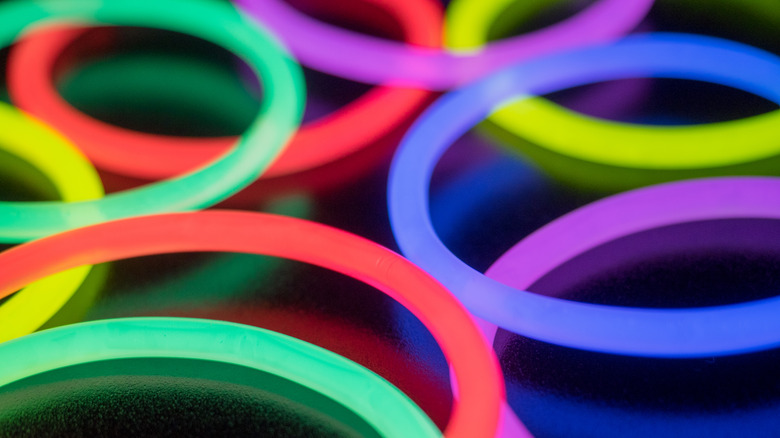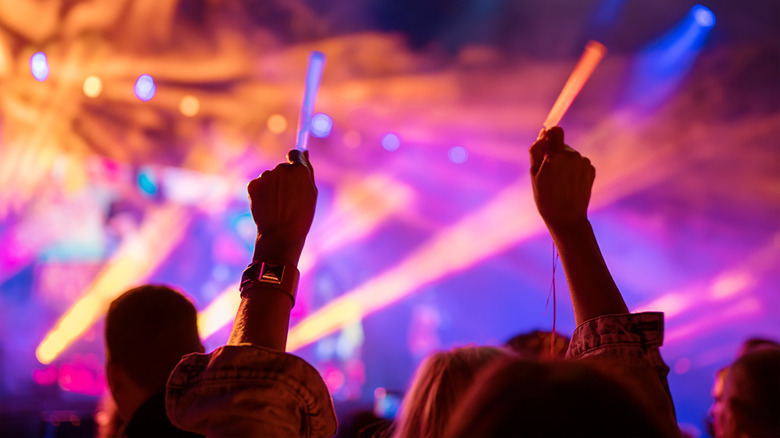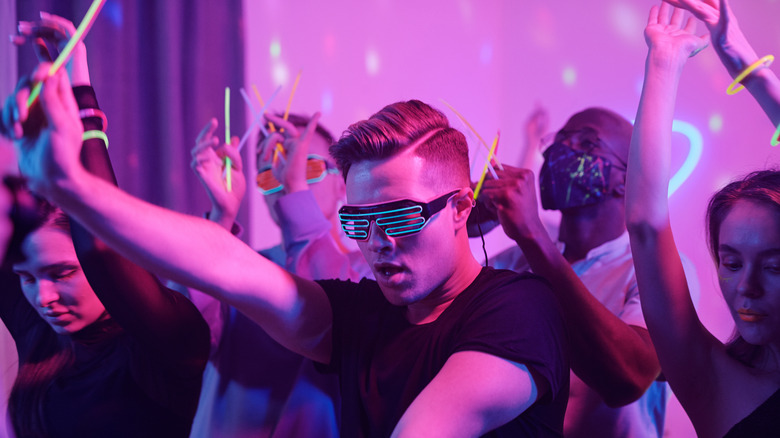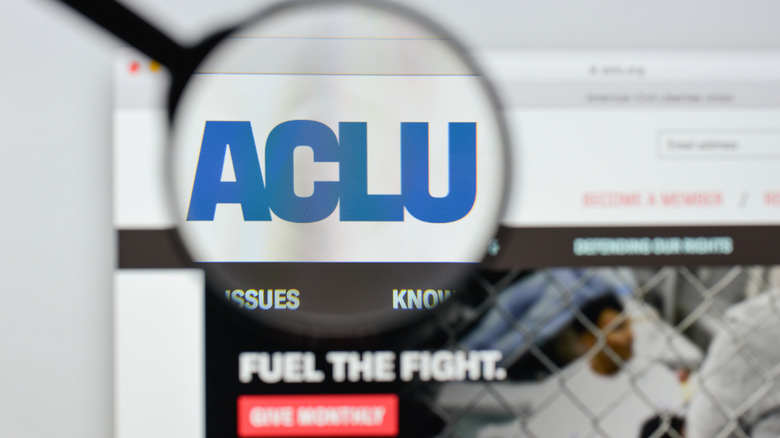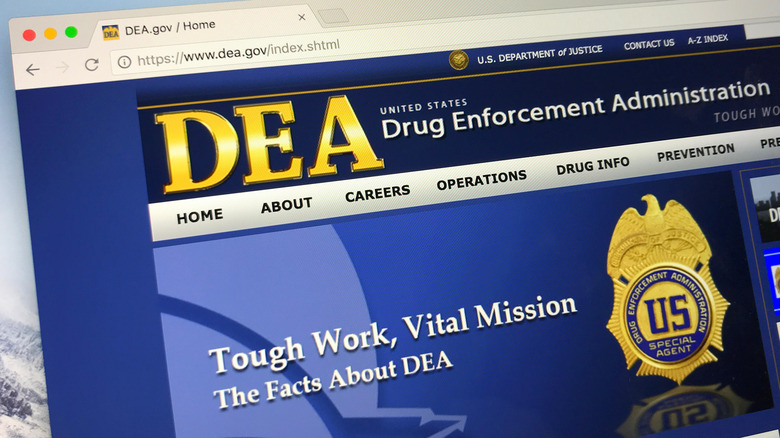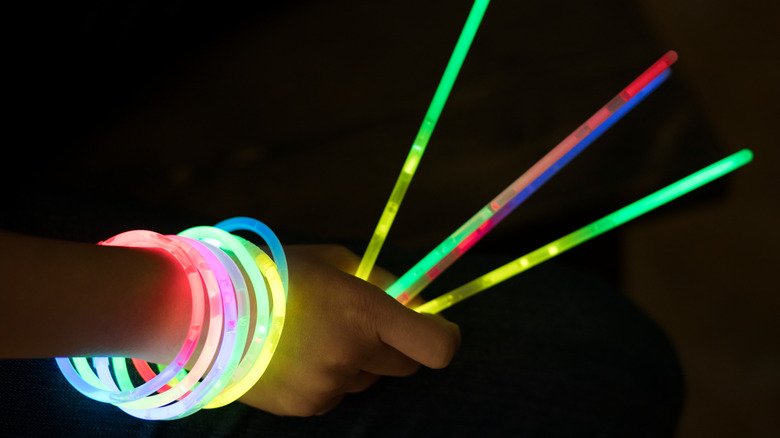The Bizarre Reason The DEA Once Tried To Ban Glow Sticks
Today if you google "glow sticks," you'll find news stories of middle and high school students using the radiant torches to practice math, light their hallways during a power outage, or serve as a baton in a "glow run." They work by a process called chemiluminescence, in which two chemicals are mixed when the shaft of the glow stick is snapped to produce light (via WIRED). They are relatively safe unless the liquid inside is ingested. According to the Children's Hospital of Philadelphia, parents often call in to report their children have ingested glow stick fluid, especially around the Fourth of July. Still, the hospital says that most glow sticks are non-toxic and won't result in more than an upset stomach.
Surprisingly, it wasn't this risk that was behind the Drug Enforcement Agency (DEA) attempt to ban this celebratory paraphernalia two decades ago. Instead, it was their connection to electronic dance parties.
Glow sticks and the Crack House Statute
The year was 2001, an inspiration for many of our fashion trends today. Britney Spears was rocking colored lenses and small sunglasses. Kylie Minogue had just released her eighth studio album, "Fever," which has made a giant comeback on the dance floor today with its hit song "Can't Get You Out of My Head." Legendary French DJ duo Daft Punk released "Discovery," which was eventually certified gold by the Recording Industry Association of America.
Raves had existed since the 1980s, but with bops like Daft Punk's new release, they were in full force in the early 2000s. In 2001, the DEA sued a venue in New Orleans, Louisiana, using the federal "crack house" statute under the pretense that ecstasy was allegedly being consumed at its parties (via MTV News). According to JSTOR, this 1986 law outlawed places where crack, cocaine, and other drugs were manufactured or used, but it was also used broadly to illegalize any venue that was aware of drug use on its properties. And the signal that the DEA was using to predict which people were using these club drugs was the glow stick, among other items.
Ecstasy and glow sticks
In the fallout of that lawsuit, the New Orleans venue ended up paying a $100,000 fine and prohibiting the use of pacifiers, masks, glow sticks, personal massagers, and "chill rooms" at future events (per MTV News). According to the Wisconsin National Drug Intelligence Center, many people taking "club drugs" like MDMA, ketamine, and GHB at raves would bring along pacifiers to stop their teeth from grinding and neon glow sticks to "enhance the effects of MDMA." This was the main reason the DEA targeted glow sticks, which they deemed "drug paraphernalia" in the suit.
There is some truth to their argument. In the early 2000s, some 30 percent of electronic nightclub attendees surveyed in the U.S. were under the influence of MDMA within the last two days, according to a study in the Journal of Drug Education. However, this wasn't indicated by the use of pacifiers or glow sticks, and other rave-goers used them in performance routines or passed out candy to spread joy on the dance floor.
The ACLU to the rescue
In response, the American Civil Liberties Union (ACLU) filed a complaint against the DEA, saying the action was just one step in a series of the "culture war against raves" (via ACLU). The ACLU claimed the toys could not be considered "drug paraphernalia" because they weren't related to the ingestion of ecstasy, MDMA, or ketamine (per HuffPost).
Director of the organization's Drug Policy Litigation Project Graham Boyd said at the time that the DEA's attempt to ban glow sticks and pacifiers was not effective at reducing drug use and instead encroached on ravers' First Amendment rights. Per ACLU, they also challenged the idea that taking away party-goers' glow sticks or pacifiers threatened their protections against "unreasonable searches and seizures." Any attempt to shut down raves, Boyd said at the time (per ACLU), would be like "shutting down rock concerts in the 1960s or jazz clubs in the 1920s because some people are using drugs."
Not the first time
In 2001, the ACLU called the action against glowsticks a "bizarre new extreme" for the government's war on drugs, but there have been similar attempts made to squash the joy found on the dance floor. During a Major League Baseball promotional event in Chicago in 1979, tens of thousands of attendees rushed the field in a chaotic riot. At the center of the riot was a pile of disco vinyl records — the dance music genre that at the time was taking the world by storm — that were set aflame like dominoes (via The Guardian). Although the event's organizer has said his intention as a rock 'n' roll fan was just to shoot friendly fire at a rival music genre, the so-called Disco Demolition Night has since been understood as an attempt to repress Black and gay music.
The DEA, established in 1973 by President Richard Nixon during the height of the war on drugs, has had its own fair share of mishaps. According to HuffPost, this includes a DEA agent shooting himself after saying moments before, "I am the only one in the room professional enough, that I know of, to carry this Glock 40."
The verdict
According to the Austin Chronicle, the 5th Circuit Court of Appeals eventually dismissed the initial ruling banning what the DEA called "drug paraphernalia," and the ban on pacifiers and glow sticks at raves and concerts was reversed. Ultimately, the judge who made the ruling said (via Stop the Drug War) that the government could not ban inherently legal objects "used in expressive communication." Either way, he noted, there was no evidence suggesting that banning these items would actually stop people from taking ecstasy.
Today, all of these items can still be found at raves. Per JSTOR, these items represent something about the innocent joy of the dance floor. It's not about the taking of drugs like ecstasy, partygoers said in an interview for the article, but rather about expressing "a desire not to let go of childhood and to remain young and carefree." Ravers rejoice: the glow sticks prevail.
